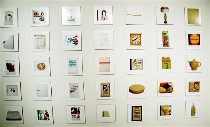Post by Colette Copeland in collaboration with Gregory Wolmart
 How do the objects we consume signify our relationship to identity, self and culture? What role does color play in our habits as consumers of products and information, and to what degree does advertising and product marketing influence these habits? For that matter, how is it that we organize objects so that they become meaningful to us? These are some of the questions I was pondering (with my friend Gregory), while walking through Anita Allyn’s installation entitled, “Life Catalog–Color Systems” on exhibit at Carbon 14 Gallery through the end of June (right and below, details of Allyn’s installation).
How do the objects we consume signify our relationship to identity, self and culture? What role does color play in our habits as consumers of products and information, and to what degree does advertising and product marketing influence these habits? For that matter, how is it that we organize objects so that they become meaningful to us? These are some of the questions I was pondering (with my friend Gregory), while walking through Anita Allyn’s installation entitled, “Life Catalog–Color Systems” on exhibit at Carbon 14 Gallery through the end of June (right and below, details of Allyn’s installation).
150 lush digital prints line the gallery’s side walls with a computer station projecting the archived data base on the back wall. The images are arranged by color, simulating a computerized color wheel–starting with white, transitioning into yelow, orange and red on the first wall, then continuing with pink, blue, green, brown and ending with black on the second wall. Allyn meticulously photographed each of her possessions, listing them by category on a web database. For the exhibit, she printed digital images from the database. Stripped of their original context, each object floats isolated in white space, frameless against the white wall. Playing with scale and juxtaposition, Allyn provides viewers with endless opportunities to create narratives and make meaning from their own associations with various objects. One of the things that struck me about the installation is the tension created by the juxtaposition of objects of learning vs. objects of pleasure. Feathered boas and spiked heels share the wall with books on feminist and queer theory.
As a child, Allyn moved constantly from place to place. Consequently, she had few possessions growing up. She recognizes her desire to collect and categorize as a way to index her sense of place. The objects house memories and stories of her experiences. They speak to the relationship between memory and materialism.
I am reminded of two books on color–Derek Jarman’s “Chroma” and David Batchelor’s “Chromophobia”. Jarman wrote “Chroma” from his hospital bed, while going blind from AIDS. Rupturing colors’ traditional symbolism, Jarman wrote about the confluence of color with his experiences and relationships. For Jarman, yellow was not a color of sunshine and happiness, but associated with piss and jaundice. Batchelor’s book “Chromophobia” references the inherent prejudice and racism in how color is used in advertising and film. Allyn’s inquiry into color subtlely frames some of the arguments that both Jarman and Batchelor employ in their essays.
 Allyn’s work calls into question some of the assumptions we have about color, such as how white is used as a symbol of status, minimalism and purity. On a less intellectual level, I wondered why there were not any green CD’s? Is this because Allyn doesn’t like the particular music with green labels? Or don’t record companies use green? Why doesn’t Glad make pink or purple garbage bags? Does this have to do market research on consumer buying habits or is it a matter of economy? Why was I so attracted to the red images/objects? Is it because psychologically they speak of passion and desire?
Allyn’s work calls into question some of the assumptions we have about color, such as how white is used as a symbol of status, minimalism and purity. On a less intellectual level, I wondered why there were not any green CD’s? Is this because Allyn doesn’t like the particular music with green labels? Or don’t record companies use green? Why doesn’t Glad make pink or purple garbage bags? Does this have to do market research on consumer buying habits or is it a matter of economy? Why was I so attracted to the red images/objects? Is it because psychologically they speak of passion and desire?
Many contemporary artists critique consumer culture. It is an easy target. Allyn’s work goes beyond a mere critique, by acknowledging both our obsessive and complicated relationship to our possessions and the role they play in forming our identity and place in the collective community and culture.
–Post by video artist Colette Copeland, who teaches at UArts and UPenn, in collaboration with Gregory Wolmart, PhD candidate in English at UPenn









